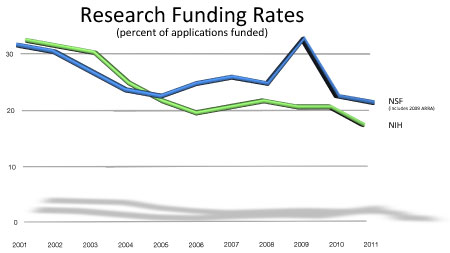Research and America’s Innovators

The people who fuel America’s innovation pipeline
Behind every transformative advance are people – scientists and engineers, students and teachers – driven by a need to know and committed to the pursuit of discovery. These individuals conduct research, run labs, teach classes, mentor young scientists, and are responsible for new discoveries, techniques and insights. They are an essential component of America’s innovation infrastructure and our pipeline to the future. Federal funding for research is what keeps this pipeline primed.
‘One of the things that make the U.S. system of research distinct from other countries is the intellectual capital and the people we mentor. This may be even more important than the actual technology and the specific ideas from our labs.’ Michael Escuti, North Carolina State University, work supported by the National Science Foundation.
Dr. Escuti has pioneered the development of liquid crystal “polarization gratings” that have many potential applications, including efficiently using lasers to transfer data between moving platforms (such as between aircraft and soldiers) and significantly improving the optical throughput of liquid crystal displays and devices.
‘If you stop investing in research and development, you very quickly cease to have any sort of leading edge in the world economy. If what we want to compete on globally is innovation, then we must start educating the scientists of tomorrow today.” Lilianne Mujica-Parodi, Stony Brook University, work supported by the Department of Defense and National Science Foundation.
Working at the intersection of theoretical physics and medicine, Dr. Mujica-Parodi is trying to better understand the human brain and the dynamics of neural response that make some people respond one way and others differently to stress and emotion. Knowing this will help identify risk factors, develop better treatments and even enable the identification of the ideal Navy SEAL candidate before that person ever goes through basic training.
‘Government funding of basic, curiosity-driven science is essential because it’s this type of research that has the greatest potential to lead to transformative discoveries. It’s through those discoveries that new industries are created and new technologies are developed.’ Noah Cowan, Johns Hopkins University, work supported by the National Science Foundation.
Dr. Cowan studies how animals process sensory information to control their movement and is leading innovative research in biologically inspired robotic systems that have applications from disaster recovery to space exploration.
Hear more from these researchers .
 Obtaining a federal research grant is extremely competitive – only the very best proposals – as judged by other scientists through merit review – receive funding. And, as the pool of available resources shrinks, it is becoming increasingly difficult to successfully compete for grant funding. At the National Science Foundation (NSF), just over 20 percent of new grant applications were funded in FY 2011, compared to 31 percent in 2001. At the National Institutes of Health (NIH), fewer than 20 percent of new grant applications reviewed in FY 2011 were funded, compared to 32 percent in 2001. These rates would decrease further as a result of sequestration. NIH Director Francis Collins has the agency would fund approximately 2,300 fewer grants in FY 2013 than it would otherwise have expected to. According to a by Research!America, NSF would see a similar decrease in grants funded in FY2013, dropping to a funding rate of only 16 percent.
Obtaining a federal research grant is extremely competitive – only the very best proposals – as judged by other scientists through merit review – receive funding. And, as the pool of available resources shrinks, it is becoming increasingly difficult to successfully compete for grant funding. At the National Science Foundation (NSF), just over 20 percent of new grant applications were funded in FY 2011, compared to 31 percent in 2001. At the National Institutes of Health (NIH), fewer than 20 percent of new grant applications reviewed in FY 2011 were funded, compared to 32 percent in 2001. These rates would decrease further as a result of sequestration. NIH Director Francis Collins has the agency would fund approximately 2,300 fewer grants in FY 2013 than it would otherwise have expected to. According to a by Research!America, NSF would see a similar decrease in grants funded in FY2013, dropping to a funding rate of only 16 percent.
Basic scientific research is an essential pillar of America’s education infrastructure. It is only through a consistently strong, federally-supported research enterprise that we will develop new generations of people committed to the pursuit of discovery and keep America’s innovation pipeline primed.
State Profiles
Learn about research activity in your state

